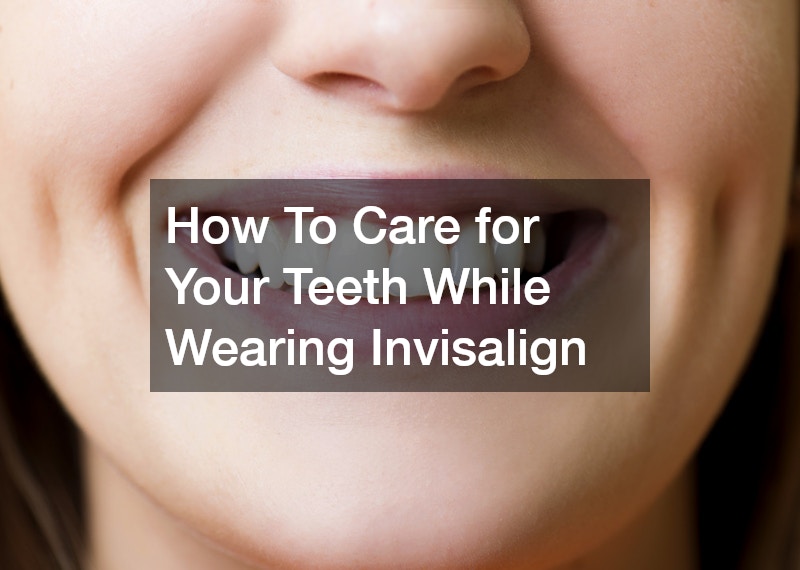How To Care for Your Teeth While Wearing Invisalign
Invisalign offers a convenient and aesthetically pleasing alternative to traditional braces, but it’s essential to maintain proper oral hygiene during treatment. In this article, we will explore the most common questions about caring for your teeth while using Invisalign and provide helpful tips to ensure your teeth remain healthy and your aligners stay in top condition.
How Often Should I Clean My Invisalign Aligners?
Daily Cleaning Routine
Maintaining a clean pair of aligners is crucial for oral health. You should rinse your aligners every time you remove them to prevent the build-up of saliva and plaque.
Brushing your aligners gently with a soft-bristled toothbrush and clear, unscented soap helps maintain their clarity. Avoid using toothpaste, which can be too abrasive and cause microscratches on the aligners.
A regular cleaning routine ensures that the aligners remain odor-free and comfortable to wear. Consistency in following a hygiene schedule will prevent any potential oral health issues.
Deep Cleaning Techniques
Beyond daily cleaning, deep cleaning your Invisalign aligners weekly helps keep them in pristine condition. A simple soak in a mixture of equal parts water and white vinegar can effectively disinfect your aligners.
Invisalign cleaning crystals are another option for removing persistent stains and ensuring long-term freshness. Place your aligners in a cleaning tub with the crystals and let them soak for about 15 minutes.
Alternatives like baking soda can also be used; making a paste with water helps remove stubborn stains. These deep cleaning techniques ensure that no harmful bacteria linger on your aligners.
What Foods and Drinks Should I Avoid While Wearing Invisalign?
Foods to Avoid
Certain foods can damage or stain your aligners, impacting their effectiveness. Sticky or chewy foods, such as caramel and gummy candies, should be avoided due to their tendency to adhere to aligners and teeth.
Hard foods like nuts or corn on the cob are also risky as they can crack or chip aligners. Efforts to minimize snack consumption between meals can help protect your aligners and oral health.
Maintaining a balanced diet of Invisalign-friendly foods ensures that your treatment progresses smoothly. Fresh fruits and vegetables, cooked soft foods, and dairy products generally pose no risk to your aligners.
Drinks Impacting Aligners
Learn about the impact of different drinks on your aligners and teeth, and find alternatives that allow you to enjoy your beverages without compromising your treatment. Coffee and tea are known culprits for staining both natural teeth and aligners; rinsing your mouth post-consumption can help mitigate this effect.
Colored soft drinks and juices contain pigments and sugar that can harm alignment trays. Switching to water as your primary beverage not only benefits your oral health but also supports overall health.
Alcoholic beverages can be heavily acidic or sugar-laden, which may negatively affect both aligners and teeth. Moderation and vigilance are key while consuming such drinks during Invisalign treatment.
How Can I Maintain Oral Hygiene While Using Invisalign?
Brushing and Flossing Tips
Explore recommended brushing and flossing techniques that cater to Invisalign users, ensuring thorough cleaning without damaging your aligners. Using a fluoride toothpaste with a gentle circular motion helps prevent decay and combat plaque build-up.
Interdental brushes or floss threaders enable easy access between teeth for those with tight spaces, essential for removing debris. Routine twice-daily brushing and once-daily flossing can be especially effective in maintaining dental health.
Adhering to these oral hygiene practices ensures that plaque isn’t building up on your teeth or aligners. This diligent care will result in healthier gums and brighter teeth throughout your treatment.
Aligner Maintenance Strategies
Understand how consistent aligner maintenance contributes to overall oral hygiene and learn strategies to incorporate these practices into your daily routine. Carefully placing and removing aligners using appropriate techniques ensures that you avoid damaging them.
Setting reminders or using apps dedicated to dental care can help you maintain an effective routine. Strategic placement of aligner cases can reduce the likelihood of misplacing or accidentally damaging them.
Incorporating these maintenance strategies into your daily habits fosters seamless integration of aligner care into dental hygiene. Effective aligner management is a cornerstone for successful orthodontic results.
Conclusion
Proper care and maintenance of both your teeth and Invisalign aligners are paramount for a successful orthodontic treatment. By following the guidelines outlined in this article, you can enjoy the benefits of Invisalign while ensuring a healthy, beautiful smile.



